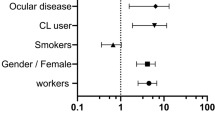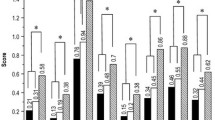Summary
A cross-sectional clinical epidemiological study was carried out among 169 office workers in four Copenhagen town halls with different prevalences of the sick building syndrome. The results were compared with those in 112 subjects randomly selected from the general population. Biomicroscopic eye manifestations, such as premature break-up of the precorneal tear film, absence of foam at the inner eye canthus and epithelial damage of the bulbar conjunctiva, were investigated together with self-reported eye complaints. Although intercorrelated, the objective eye manifestations independently were statistically associated with self-reported eye complaints in office workers. The prevalence of the objective eye manifestations was significantly elevated in office workers compared with the general population and most pronounced for the buildings with a high prevalence of the sick building syndrome (P < 0.001). In the general population, subjects with a non-industrial occupation, including office workers, had a significantly higher prevalence of objective eye manifestations than those with an industrial occupation (P = 0.03), but the prevalence was still significantly lower than that among the office workers in buildings with a high prevalence of the sick building syndrome (P<0.001). Since possible confounders were found not to explain the difference in prevalence of objective eye manifestations and complaints among the two populations, it is concluded that the office environment (buildings and/or type of office work) promotes these objective changes accompanied by self-reported complaints.
Similar content being viewed by others
References
Berglund B, Lindvall T (1986) Sensory reactions to “sick buildings”. Environ Int 12:147–159
Editorials (1991) Sick building syndrome. Lancet 338:1493–1494
Finnegan MJ, Pickering CAC, Burge PS (1984) The sick building syndrome: prevalence studies. Br Med J 289:1573–1575
Franck C (1986) Eye symptoms and signs in buildings with indoor climate problems (‘office eye syndrome’). Acta Ophthalmol (Copenh) 64:306–311
Franck C (1991) Fatty layer of the precorneal film in the ‘office eye syndrome’. Acta Ophthalmol (Copenh) 69:114–120
Franck C, Skov P (1989) Foam at inner eye canthus in office workers, compared with an average Dansih population as control group. Acta Ophthalmol (Copenh) 67:61–68
Franck C, Skov P (1991) Evaluation of two different questionnaires used for diagnosing ocular manifestations in the sick building syndrome on the basis of an objective index. Indoor Air 1:5–11
Hedge A, Burge PS, Robertson AS, Wilson S, Harris-Bass J (1989) Work related illness in offices: a proposed model of the sick building syndrome. Environ Int 15:143–158
Hodgson MJ, Frohliger J, Permar E, et al. (1991) Symptoms and microenvironmental measures in nonproblem buildings. Occup Med 33:527–533
Mendell MJ, Smith AH (1990) Consistent pattern of elevated symptoms in air-conditioned office buildings: a reanalysis of epidemiologic studies. Am J Public Health 80:1193–1199
Nordbäck D, Torgén M, Edling C (1990) Volatile organic compounds, respirable dust, and personal factors related to prevalence and incidence of sick building syndrome in primary schools. Br Ind Med 47:733–741
Nordbäck D, Edling C (1991) Environmental, occupational, and personal factors related to the prevalence of sick building syndrome in the general population. Br J Ind Med 48:451–462
Norn M (1983) External eye, methods of examination. Scriptor 80, Copenhagen
Norn M (1987) Foam in the external part of the eye. Acta Ophthalmol (Copenh) 65:143–146
Skov P, Valbjørn O (1987) The “sick” building syndrome in the office environment: the danish town hall study. Environ Intl 3:339–349
Skov P, Valbjørn O, Pedersen BV (1989) Influence of personal characteristics, job related factors and psychosocial factors on the sick building syndrome. Scand J Work Environ Health 15:286–295
Skov P, Valbjørn O, Pedersen BV (1990) Influence of indoor climate on the sick building syndrome in an office environment. Scand J Work Environ Health 16:363–371
Author information
Authors and Affiliations
Rights and permissions
About this article
Cite this article
Franck, C., Bach, E. & Skov, P. Prevalence of objective eye manifestations in people working in office buildings with different prevalences of the sick building syndrome compared with the general population. Int. Arch Occup Environ Heath 65, 65–69 (1993). https://doi.org/10.1007/BF00586061
Received:
Accepted:
Issue Date:
DOI: https://doi.org/10.1007/BF00586061




